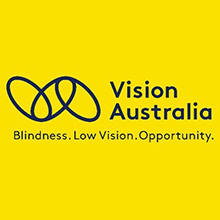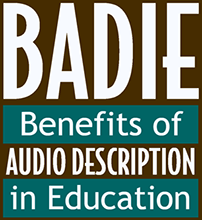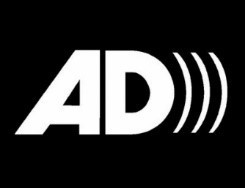 |
 |
 |
Congratulations to all those who entered last year’s BADIE-AU competition to tell us what they thought about something they’ve experienced with Audio Description!
Our winner was Morgan whose chose to review not one piece of AD, but several! She also explained why audio description is so important for kids, and how we can advocate for it. You can read her review below.
Inspired by Morgan, this year is all about quantity! We’re challenging you to become an expert user of AD and see how much you can experience over the next 12 months… Keep checking back here to find out more soon…
If you have any questions about AD for children and young people please contact [email protected].
Morgan's winning entry
“My name is Morgan and I am in year 5. I am completely blind therefore I find audio description extremely helpful.
I was very interested in the competition but I decided it would be better to write a critical analysis of the audio description of several shows. The shows I will be referencing are.
- free rein
- The worst witch
- Lemony Snicket’s a series of unfortunate events
- Raising Dion
- My little pony
These shows were all accessed on Netflix because no other streaming service provided audio description. I found this very annoying because I did this in school time and for some shows you can only access audio description if the show was live.
My critical analysis will look at these three areas of audio description. Quality of voice, quality of description and access to audio description.
The quality of the voice is a very important part of audio description. Qualities of a good voice are clarity, expression and a weak accent. A voice needs to be clear so that the person listening can understand the person speaking e.g. in Lemony Snicket’s a series of unfortunate events I found it hard to understand the person speaking because she had a very strong accent so her voice wasn’t very clear. A voice also needs to have good expression especially in the action moments e.g. when I was watching Lemony Snicket a services of unfortunate events my older sister was concerned that it would be too scary for me. She thought this because she could see that the pictures on the screen were scary but the voice [didn’t express this. I didn’t know it was supposed to be scary.]
Another important part of audio description is the quality of the description. Good description needs to use space between the dialogue well and describe every thing that is happening. Effective use of the spaces between the dialogue enables the person listening to get a greater understanding of what is happening e.g. in the worst witch they used the space between the dialogue to describe what is happening and to help the person listening get a better understanding of the show. Describing every thing that is happening is another crucial part of good audio description. If some things are not described the person watching will not get a full understanding of the show e.g. in Raising Dion they described some things but they missed major part of the story like what the people were doing and where they were. The words they use are sometimes not the right words for the intended age group e.g. in my little pony they used the word stealthily which would be hard for the intended age group to understand.
The final part of audio description is easy access. I searched for audio description on several streaming services but I found it was very hard to find shows that had audio description however every show I found had closed captions. Even the Australian Broadcasting Corporation didn’t have audio description except if the show was live. Some shows also do not advertise audio description even when it is accessible e.g. on netflix the shows had audio description but it was not advertised so I didn’t know if the show had audio description.
I recommend that we create an audio description criteria designed by people who are blind or have low vision. We can ask for this through the Human Rights Commissioner because they would have more control over the equity of access to audio description.
I also think that audio description should be worldwide and on every streaming service so that people who are blind can have the same access to shows as sighted people.
I realise that I have not met the criteria for this competition but I thought it would be more challenging to write a critical analysis and make my recommendations for the future.”
Quick quiz with our winner
We wanted to hear from Morgan.
Morgan, tell us why you use audio description?
"I use audio description so I know what is happening as some shows have very little dialogue or the dialogue doesn’t enable me to know what is happening i.e. the action taking place."
What did you choose to write your review on and why?
"I chose to write a critical analysis of audio description. I noticed there are limited shows or streaming platforms that have audio description. Whereas closed captions were almost always available. I decided to investigate what makes good quality audio description. I watched several shows and made notes. I then organised my notes to identify three parameters for good quality audio description. I then learnt how to construct a critical analysis. I reflected on my notes and the parameters I had identified and then wrote my critical analysis which I decided actually could be used as guidelines for audio description across all platforms. I was encouraged to look at this task from an advocacy perspective. I would like to see my guidelines taken to the Human Rights Commissioner and eventually be used in all audio descriptions."
How would you encourage other kids to use audio description?
"The television networks and the streaming services should advertise when they have audio description available. This information will reach parents, teachers and the students. It will also encourage more people to advocate for easily accessible audio description on all programs. Advertising for audio description should also appear on facebook."
And finally, what TV show or film would you love to be audio described?
"The television networks and the streaming services should advertise when they have audio description available. This information will reach parents, teachers and the students. It will also encourage more people to advocate for easily accessible audio description on all programs. Advertising for audio description should also appear on facebook."
What is audio description?
Audio Description is visual information conveyed through words. It translates things that are visible into things that you can hear. With Audio Description you don’t need to see in order to understand what is happening because all the important visual information is spoken out loud.
Check out this example of the audio described trailer for Frozen:
With the recent inclusion of audio description on the ABC and SBS (not to mention dvds, cinemas and streaming platforms), young Australians have more opportunities than ever to access content through Audio Description.
BADIE-AU recognises the pivotal role that audio-visual content plays in education, culture and society. Play your part in developing a nation of informed (and demanding!) audio description consumers – the more you make your voice heard, the more audio description there will be, and the better that audio description can be!
Need help finding some audio description? See here for the different places you can find Audio Described content.
Or look out for the Audio Description logo:

Vision Australia is thrilled to partner with the American Council for the Blind and its Audio Description Project to bring the BADIE initiative to Australia. Our goal is to nurture and reward critical engagement with audio description by young Australians who are blind or have low vision. Enormous thanks to the American Council of the Blind, its Audio Description Project/BADIE Committee, and the Described and Captioned Media Program in the U.S. for their permission to use the name and format of the BADIE initiative, and for all their amazing support in the development of this Australian chapter. You can find out more about the original initiative here: https://dcmp.org/learn/657-lil-badie Vision Australia is thrilled to partner with the American Council for the Blind and its Audio Description Project to bring the BADIE initiative to Australia. Our goal is to nurture and reward critical engagement with audio description by young Australians who are blind or have low vision. Enormous thanks to the American Council of the Blind, its Audio Description Project/BADIE Committee, and the Described and Captioned Media Program in the U.S. for their permission to use the name and format of the BADIE initiative, and for all their amazing support in the development of this Australian chapter. Find out more about the original initiative.










